Showing Spotlights 2321 - 2328 of 2838 in category All (newest first):
 The past few years have seen tremendous progress in developing and fine-tuning fabrication methods for nanoparticles. An important research direction in nanoparticle synthesis is the expansion from single-component nanoparticles to hybrid nanostructures that possess two or more functional properties thanks to the integration of different materials. Multifunctional nanocarriers are a particularly hot topic in nanomedicine where it is hoped that such particles can significantly enhance the efficacy of many therapeutic and diagnostic protocols. What makes hybrid multicomponent nanostructures so alluring is not only the combination of different functionalities, but also the possibility to independently optimize the dimension and material parameters of the individual components. Apart from their multifunctionality, another advantage of these structures is that they can provide novel functions not available in single-component materials. A recent feature article provides an overview of the synthetic efforts of multicomponent hybrid nanoparticles via high-temperature solution-phase synthesis. The topics include chemical synthesis of multicomponent nanoparticles; characterization of the structural and physical properties, especially the ones arising from the interactions between different components; and potential applications of these multicomponent hybrid nanoparticles.
The past few years have seen tremendous progress in developing and fine-tuning fabrication methods for nanoparticles. An important research direction in nanoparticle synthesis is the expansion from single-component nanoparticles to hybrid nanostructures that possess two or more functional properties thanks to the integration of different materials. Multifunctional nanocarriers are a particularly hot topic in nanomedicine where it is hoped that such particles can significantly enhance the efficacy of many therapeutic and diagnostic protocols. What makes hybrid multicomponent nanostructures so alluring is not only the combination of different functionalities, but also the possibility to independently optimize the dimension and material parameters of the individual components. Apart from their multifunctionality, another advantage of these structures is that they can provide novel functions not available in single-component materials. A recent feature article provides an overview of the synthetic efforts of multicomponent hybrid nanoparticles via high-temperature solution-phase synthesis. The topics include chemical synthesis of multicomponent nanoparticles; characterization of the structural and physical properties, especially the ones arising from the interactions between different components; and potential applications of these multicomponent hybrid nanoparticles.
Mar 19th, 2008
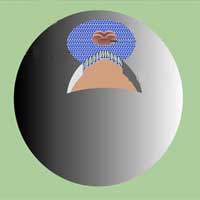 Understanding and manipulating cellular function at the level of individual molecules is within reach. One of the requirements of single molecule techniques is the ability to follow an individual molecule for sufficiently long times in solution. However, it is a challenge to cope with the effects of Brownian motion (the random motion of small particles suspended in a gas or liquid) on this time scale. To meet this challenge, more recently, biomolecules have been encapsulated inside lipid vesicles, which are themselves tethered to a surface. Now, a novel nanocontainer offers controlled permeability functionality which not only is desirable for single molecule imaging but also is a very important property for micro- and nanodevices and for delivery of drugs or imaging agents in vitro and in vivo.
Understanding and manipulating cellular function at the level of individual molecules is within reach. One of the requirements of single molecule techniques is the ability to follow an individual molecule for sufficiently long times in solution. However, it is a challenge to cope with the effects of Brownian motion (the random motion of small particles suspended in a gas or liquid) on this time scale. To meet this challenge, more recently, biomolecules have been encapsulated inside lipid vesicles, which are themselves tethered to a surface. Now, a novel nanocontainer offers controlled permeability functionality which not only is desirable for single molecule imaging but also is a very important property for micro- and nanodevices and for delivery of drugs or imaging agents in vitro and in vivo.
Mar 18th, 2008
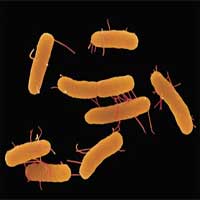 The U.S. Food and Drug Administration has published a handbook called the Bad Bug Book which provides basic facts regarding foodborne pathogenic microorganisms and natural toxins. It contains all you always wanted to know about Salmonella, E. coli, parasitic protozoa, worms, viruses and natural toxins and other stuff that, when it gets in your hamburger, as it does from time to time, can make you pretty sick. It can even kill you. The Centers for Disease Control and Prevention (CDC) keep some pretty scary statistics and estimate that foodborne pathogens cause approximately 76 million illnesses, 325,000 hospitalizations, and 5,000 deaths in the United States each year. Three pathogens, Salmonella, Listeria, and Toxoplasma, are responsible for 1,500 deaths each year. Salmonella is the most common cause of foodborne deaths and responsible for millions of cases of foodborne illness a year. Sources are raw and undercooked eggs, undercooked poultry and meat, dairy products, seafood, fruits and vegetables - so basically more or less everything you eat. Early detection of foodborne pathogenic bacteria, especially Salmonella, is therefore an important task in microbiological analysis to control food safety. Several methods have been developed in order to detect this pathogen; however, the biggest challenges remain detection speed and sensitivity. A novel nanotechnology-based biosensor is showing great potential for foodborne pathogenic bacteria detection with high accuracy.
The U.S. Food and Drug Administration has published a handbook called the Bad Bug Book which provides basic facts regarding foodborne pathogenic microorganisms and natural toxins. It contains all you always wanted to know about Salmonella, E. coli, parasitic protozoa, worms, viruses and natural toxins and other stuff that, when it gets in your hamburger, as it does from time to time, can make you pretty sick. It can even kill you. The Centers for Disease Control and Prevention (CDC) keep some pretty scary statistics and estimate that foodborne pathogens cause approximately 76 million illnesses, 325,000 hospitalizations, and 5,000 deaths in the United States each year. Three pathogens, Salmonella, Listeria, and Toxoplasma, are responsible for 1,500 deaths each year. Salmonella is the most common cause of foodborne deaths and responsible for millions of cases of foodborne illness a year. Sources are raw and undercooked eggs, undercooked poultry and meat, dairy products, seafood, fruits and vegetables - so basically more or less everything you eat. Early detection of foodborne pathogenic bacteria, especially Salmonella, is therefore an important task in microbiological analysis to control food safety. Several methods have been developed in order to detect this pathogen; however, the biggest challenges remain detection speed and sensitivity. A novel nanotechnology-based biosensor is showing great potential for foodborne pathogenic bacteria detection with high accuracy.
Mar 17th, 2008
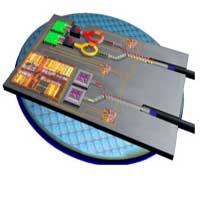 In its everlasting quest to deliver more data faster and on smaller components, the silicon industry is moving full steam ahead towards its final frontiers of size, device integration and complexity. We have covered this issue numerous times in previous Spotlights. As the physical limitations of metallic interconnects begin to threaten the semiconductor industry's future, one group of researchers and companies is betting heavily on advances in photonics that will lead to combining existing silicon infrastructure with optical communications technology, and a merger of electronics and photonics into one integrated dual-functional device. Today, silicon underpins nearly all microelectronics but the end of the road for this technology has clearly come into view. Photonics is the technology of signal processing, transmission and detection where the signal is carried by photons (light) and it is already heavily used in photonic devices such as lasers, waveguides or optical fibers. Optical technology has always suffered from its reputation for being an expensive solution, due to its use of exotic materials and expensive manufacturing processes. This prompted research into using more common materials, such as silicon, for the fabrication of photonic components, hence the name silicon photonics. Although fiber-optic communication is a well-established technology for information transmission, the challenge for silicon photonics is to manufacture low-cost information processing components. Rather than building an entirely new industrial infrastructure from scratch, the goal here is to to develop silicon photonic devices manufactured using standard CMOS techniques. A recent review paper takes a look at the state of silicon photonics and identifies the challenges that remain on the path to commercialization.
In its everlasting quest to deliver more data faster and on smaller components, the silicon industry is moving full steam ahead towards its final frontiers of size, device integration and complexity. We have covered this issue numerous times in previous Spotlights. As the physical limitations of metallic interconnects begin to threaten the semiconductor industry's future, one group of researchers and companies is betting heavily on advances in photonics that will lead to combining existing silicon infrastructure with optical communications technology, and a merger of electronics and photonics into one integrated dual-functional device. Today, silicon underpins nearly all microelectronics but the end of the road for this technology has clearly come into view. Photonics is the technology of signal processing, transmission and detection where the signal is carried by photons (light) and it is already heavily used in photonic devices such as lasers, waveguides or optical fibers. Optical technology has always suffered from its reputation for being an expensive solution, due to its use of exotic materials and expensive manufacturing processes. This prompted research into using more common materials, such as silicon, for the fabrication of photonic components, hence the name silicon photonics. Although fiber-optic communication is a well-established technology for information transmission, the challenge for silicon photonics is to manufacture low-cost information processing components. Rather than building an entirely new industrial infrastructure from scratch, the goal here is to to develop silicon photonic devices manufactured using standard CMOS techniques. A recent review paper takes a look at the state of silicon photonics and identifies the challenges that remain on the path to commercialization.
Mar 14th, 2008
 You have seen the effect: if you splash water on your car it leaves wet areas; if you do this with your freshly polished car the drops just pearl off. Materials scientists are very interested in designing surfaces that allow them to control this effect - called wetting - because it enables them to fabricate things like more comfortable contact lenses, better prosthetics, and self-cleaning materials. The primary measurement to determine wettability is the angle between the solid surface and the surface of a liquid droplet on the solid's surface. For example, a droplet of water on a hydrophobic surface would have a high contact angle, but a liquid spread out on a hydrophilic surface would have a small one. Maintaining the position of a drop of water on a hydrophobic surface (e.g. your newly waxed car) appears to be impossible - it will just move across the surface. Scientists in Israel have managed to fabricate a nanostructured, highly hydrophobic surface that allows them to pin a nearly spherical drop of water in place. A droplet sitting on one class of these substrates did not fall even after the substrate was turned upside-down! An important application for this novel fabrication technique could be as a tool in single-molecule spectroscopy: a water drop, containing molecules to be probed, could be pinned down for an extended time, allowing to spectroscopically probe it for long periods without affecting the properties of molecules, or even just one molecule, dissolved in the water drop.
You have seen the effect: if you splash water on your car it leaves wet areas; if you do this with your freshly polished car the drops just pearl off. Materials scientists are very interested in designing surfaces that allow them to control this effect - called wetting - because it enables them to fabricate things like more comfortable contact lenses, better prosthetics, and self-cleaning materials. The primary measurement to determine wettability is the angle between the solid surface and the surface of a liquid droplet on the solid's surface. For example, a droplet of water on a hydrophobic surface would have a high contact angle, but a liquid spread out on a hydrophilic surface would have a small one. Maintaining the position of a drop of water on a hydrophobic surface (e.g. your newly waxed car) appears to be impossible - it will just move across the surface. Scientists in Israel have managed to fabricate a nanostructured, highly hydrophobic surface that allows them to pin a nearly spherical drop of water in place. A droplet sitting on one class of these substrates did not fall even after the substrate was turned upside-down! An important application for this novel fabrication technique could be as a tool in single-molecule spectroscopy: a water drop, containing molecules to be probed, could be pinned down for an extended time, allowing to spectroscopically probe it for long periods without affecting the properties of molecules, or even just one molecule, dissolved in the water drop.
Mar 13th, 2008
 Notwithstanding the mixed news (to put it mildly) that individual investors have been getting from their nanotechnology stock portfolios, industry as a whole is pressing ahead with incorporating nanotechnologies in their products and processes. Unlike many other areas of science, nanosciences are capable of influencing a wide sweep of industrial and medical processes, from cleaner energy applications, to smart materials and revolutionary medical applications. It is increasingly difficult to know which products use nanotechnology or incorporate nanomaterials; nanotechnology consumer product directories give an idea where nanomaterials are used but are increasingly useless in helping to understand the full extent of nanotechnologies penetrating industrial manufacturing processes. Some consumer companies embrace 'nano' wholeheartedly and advertise their 'revolutionary' face creams, tennis rackets and car waxes; some, after increased scrutiny, have become very quiet about their nanotechnology activities (especially the large cosmetics and food companies); and some even change their company name to something that doesn't include 'nano' ('cleantech' or 'greentech' has become the new nanotech). Combine this technological shift that is taking place in industries across the board with the still existing lack of conclusive answers about the toxicity of nanomaterials, and you get a worrisome mix of industry pushing ahead unconstrained, a regulatory environment where key constituencies are ill prepared and underfunded to address the issues with the speed required, and public opinion that covers the whole range from activists calling for a complete moratorium on all things nano to snake-oil salesmen who promise nanotechnology stock tips that will make you a gazillionaire. Oh, and apparently now you can also add to this mix certain religious types in the U.S. who find nanotechnology is morally not acceptable.
Notwithstanding the mixed news (to put it mildly) that individual investors have been getting from their nanotechnology stock portfolios, industry as a whole is pressing ahead with incorporating nanotechnologies in their products and processes. Unlike many other areas of science, nanosciences are capable of influencing a wide sweep of industrial and medical processes, from cleaner energy applications, to smart materials and revolutionary medical applications. It is increasingly difficult to know which products use nanotechnology or incorporate nanomaterials; nanotechnology consumer product directories give an idea where nanomaterials are used but are increasingly useless in helping to understand the full extent of nanotechnologies penetrating industrial manufacturing processes. Some consumer companies embrace 'nano' wholeheartedly and advertise their 'revolutionary' face creams, tennis rackets and car waxes; some, after increased scrutiny, have become very quiet about their nanotechnology activities (especially the large cosmetics and food companies); and some even change their company name to something that doesn't include 'nano' ('cleantech' or 'greentech' has become the new nanotech). Combine this technological shift that is taking place in industries across the board with the still existing lack of conclusive answers about the toxicity of nanomaterials, and you get a worrisome mix of industry pushing ahead unconstrained, a regulatory environment where key constituencies are ill prepared and underfunded to address the issues with the speed required, and public opinion that covers the whole range from activists calling for a complete moratorium on all things nano to snake-oil salesmen who promise nanotechnology stock tips that will make you a gazillionaire. Oh, and apparently now you can also add to this mix certain religious types in the U.S. who find nanotechnology is morally not acceptable.
Mar 12th, 2008
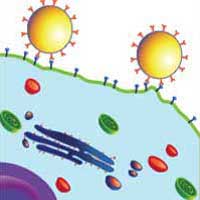 A new study reveals that nanoparticles do not just act as simple, passive carriers but are actively involved in mediating biological activity. These findings have significant implications in understanding the interactions of nanostructures with biological systems. But, once properly understood, they could be important in assisting in the design of intelligent nanodevices, with great potential for the development of novel molecular-based diagnostics and therapeutics. On the other hand, they could also be useful in understanding nanotoxicity. In spite of what has been achieved so far by scientists and clinical researchers, a complete understanding of how cells interact with nanostructures of well-defined sizes, at the molecular level, remains poorly understood.
A new study reveals that nanoparticles do not just act as simple, passive carriers but are actively involved in mediating biological activity. These findings have significant implications in understanding the interactions of nanostructures with biological systems. But, once properly understood, they could be important in assisting in the design of intelligent nanodevices, with great potential for the development of novel molecular-based diagnostics and therapeutics. On the other hand, they could also be useful in understanding nanotoxicity. In spite of what has been achieved so far by scientists and clinical researchers, a complete understanding of how cells interact with nanostructures of well-defined sizes, at the molecular level, remains poorly understood.
Mar 11th, 2008
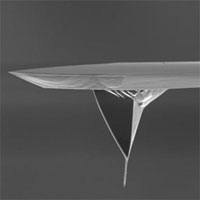 Discover AFM's role in nanotechnology with our in-depth guide on its working principle, applications, and future trends in nanoscale imaging and characterization.
Discover AFM's role in nanotechnology with our in-depth guide on its working principle, applications, and future trends in nanoscale imaging and characterization.
Mar 10th, 2008
 The past few years have seen tremendous progress in developing and fine-tuning fabrication methods for nanoparticles. An important research direction in nanoparticle synthesis is the expansion from single-component nanoparticles to hybrid nanostructures that possess two or more functional properties thanks to the integration of different materials. Multifunctional nanocarriers are a particularly hot topic in nanomedicine where it is hoped that such particles can significantly enhance the efficacy of many therapeutic and diagnostic protocols. What makes hybrid multicomponent nanostructures so alluring is not only the combination of different functionalities, but also the possibility to independently optimize the dimension and material parameters of the individual components. Apart from their multifunctionality, another advantage of these structures is that they can provide novel functions not available in single-component materials. A recent feature article provides an overview of the synthetic efforts of multicomponent hybrid nanoparticles via high-temperature solution-phase synthesis. The topics include chemical synthesis of multicomponent nanoparticles; characterization of the structural and physical properties, especially the ones arising from the interactions between different components; and potential applications of these multicomponent hybrid nanoparticles.
The past few years have seen tremendous progress in developing and fine-tuning fabrication methods for nanoparticles. An important research direction in nanoparticle synthesis is the expansion from single-component nanoparticles to hybrid nanostructures that possess two or more functional properties thanks to the integration of different materials. Multifunctional nanocarriers are a particularly hot topic in nanomedicine where it is hoped that such particles can significantly enhance the efficacy of many therapeutic and diagnostic protocols. What makes hybrid multicomponent nanostructures so alluring is not only the combination of different functionalities, but also the possibility to independently optimize the dimension and material parameters of the individual components. Apart from their multifunctionality, another advantage of these structures is that they can provide novel functions not available in single-component materials. A recent feature article provides an overview of the synthetic efforts of multicomponent hybrid nanoparticles via high-temperature solution-phase synthesis. The topics include chemical synthesis of multicomponent nanoparticles; characterization of the structural and physical properties, especially the ones arising from the interactions between different components; and potential applications of these multicomponent hybrid nanoparticles.
 Subscribe to our Nanotechnology Spotlight feed
Subscribe to our Nanotechnology Spotlight feed





